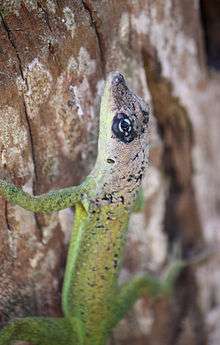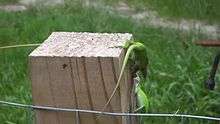Dactyloidae
| Dactyloidae | |
|---|---|
 | |
| Carolina anole with dewlap extended | |
| Scientific classification | |
| Kingdom: | Animalia |
| Phylum: | Chordata |
| Class: | Reptilia |
| Order: | Squamata |
| Suborder: | Lacertilia |
| Family: | Dactyloidae |
| Genera | |
The Dactyloidae are a family of lizards commonly known as anoles /əˈnoʊliːz/. The NCBI places the anole in subfamily Polychrotinae of the family Iguanidae.[1] The family is generally considered to be monotypic, containing only the genus Anolis; however, recent genetic research has identified several clades within Anolis that may sometimes be elevated to generic status. These clades are: Dactyloa, Deiroptyx, Ctenonotus, Xiphosurus, Norops, Chamaelinorops, Anolis (exclusive of the other recognized monophyletic clades) and Audantia.[2]
The genus Polychrus was previously also placed in the family under the family name Polychrotidae; however recent genetic studies confirm that Polychrus is not closely related to Anolis and is in fact closer to Hoplocercidae. Therefore, Polychrotidae as a family has been invalidated, which classifies Polychrus under subfamily Polychrotinae and family Iguanidae.[3][4]
Due to their ability to change color, anolis (anole) lizards are frequently referred to as American chameleons. Anolis lizards also share many characteristics with geckos. However anoles are not closely related to either of those groups, they are most closely related to iguanas. Anoles share many anatomical features with arboreal iguanas. These similarities include skeletal structure and nearly identical foot structure.
Characteristics and distribution

Anoles are small and common lizards that can be found throughout the southeastern United States and at least as far west as San Antonio and Texas Hill Country, the Caribbean, Mexico, and various other warm regions of the Western world. A large majority of them sport a green coloration, including the only species native to the United States, the aptly named green anole. The green anole (and many other anoles) can change its color based on stress level, sun/light exposure and its surrounding. Although their color changing ability is very limited, often anoles are only able to change one color. Anoles are a very diverse and plentiful group of lizards, and about 372 species are known. The knight, green, bark, Jamaican giant, and Cuban brown anoles can all be found in the United States, primarily in Florida. The most prevalent of these species by far is the Cuban brown anole, which has pushed the native green (or "Carolina") anole population farther north.
When green anoles and brown anoles inhabit the same area, the brown anoles are primarily terrestrial or restrict themselves to the lower branches of bushes, while the green anoles stay higher. Brown anoles have also spread into East Texas. At a nursery in the Heights neighborhood of Houston, Texas, a stable population has established itself, hatchlings having been observed in the spring of 2005.[5]
While nearly all anoles can change their color, the extent and variations of this ability differ widely throughout the individual species. For example, the green anole can change its color from a bright, leafy green to a dull brown color, while the Cuban brown can only change its shade of brown, along with the patterns on its back.

Many anoles are between eight and 18 cm (3–7 in) in length. Some larger species, such as the knight anole, can surpass 12 in (300 mm); some males of the knight anole species can even reach 20 in (510 mm) in length.
Anoles' diets include live insects and other invertebrates, with crickets, spiders, and moths being some of the most commonly consumed prey. They have been seen to eat butterflies.[6] Anoles are opportunistic feeders, and may attempt to eat any attractive meal that is small enough. The primary foods for captive anoles are small feeder crickets that can be purchased at most pet stores.
These subtropical lizards are semiarboreal. They usually inhabit regions around 3–6 m (9.8–19.7 ft) high. Shrubs, walls, fences, bushes, and short trees are common hiding places.
Most anoles are said to live between four and eight years. Even anoles captured from the wild can live for several years if given acceptable living space and cared for properly; a healthy anole in captivity, being free from predators and natural disaster, may live well beyond seven years. Some anoles may even reach 14 years with careful and proper care.
Breeding occurs for several months beginning in late spring. Males employ head bobbing and dewlap extension in courtship. One or two small, soft-shelled eggs are laid among leaf litter. More clutches may be laid before mating season has ended.
Anoles have many readily identifiable features. They have dewlaps, made of erectile cartilage, that extend from their neck/throat areas. The dewlap may serve as a signal for attracting mates, winning contests, and communicating condition.[7][8] Underneath an anoles toes are pads that have several to a dozen flaps of skin going horizontally covered in microscopic hairlike protrusions that allow them to cling to many different surfaces, much like a gecko. Also, their tails have the ability to break off at special segments to escape predators. The tail continues to wriggle strongly for some minutes after detaching. This ability is known as autotomy. Anoles are also diurnal - active during the daytime.
Some species of anoles exhibit sexual dimorphism, which allows one to discern between males and females fairly easily with the naked eye. In green anoles, the female is characterized by a pale dorsal stripe extending from the neck to the tail, a generally smaller body, and a smaller head with a shorter snout. Female brown anoles share these characteristics, although their dorsal stripes are often wider, with diamond-shaped or squiggly edges. This stripe may be present sometimes in males, especially young ones not yet fully grown, but it is always fainter with less-defined edges. Some females have small dewlaps (pale and much smaller than those of the males).
Evolution and adaptability
On the website Anole Annals, Martha Munoz calls attention to a 2012 paper ("Rapid Change in the Thermal Tolerance of a Tropical Lizard") by scientists Alex Gunderson and Manuel Leal of Duke University, in which they examine whether physiology has evolved in the invasive populations of Anolis cristatellus (the Puerto Rican crested anole) in Florida:
Anolis lizards are a model system for studies of evolutionary ecology because they are remarkably adaptable creatures. We know from long-term studies...that anoles can rapidly adapt their behavior and morphology over ecological timescales. For example, the presence of a ground-dwelling predator (Leiocephalus carinatus) forged a strong selective gradient in favor of A. sagrei with longer hindlimbs within a single generation. Interestingly, in a follow-up study the long-term effect of this predator is that A. sagrei evolves shorter hindlimbs, as they will tend to perch higher off the ground, where the perch diameter is narrower than near the ground. ...A notable exception to Anolis 'evolvability,' however, is thermal physiology... Although native to the Puerto Rico, A. cristatellus has made a permanent home in Florida... In a previous study, Jason Kolbe and colleagues demonstrated that the thermal niches (i.e., available thermal habitat) are quite divergent between Puerto Rico and Florida, and showed a rapid evolutionary response in acclimation to thermal environment in one of the invasive populations. This sets up the possibility that invading anoles will evolve their thermal physiology to match their new environment... [A]lthough thermal physiology is predominantly conserved among lizards, anoles are a notable exception to this rule.[9]
Anole populations in each of the Martinique islands, despite remaining separate for an estimated six to eight million years, have not experienced significant evolution, and many mixed-island couples have successfully reproduced.[10]
In a recent study from the University of Texas, one species of anole were shown to be able to evolve rapidly in response to the invasion of another species. A. carolinensis are native to the southeastern United States as well as small islands off the coast of Florida. A. sagrei is a species native to Cuba that has been slowly invading A. carolinensis habitats. In response to the presence of A. sagrei, A. carolinensis moved to higher perches and adapted larger toepads better suited for those perches. The adaptation that as observed occurred in just 20 generations. This study showed that anoles have the ability to evolve in a remarkably short time frame in response to changing environmental conditions.[11]
Territory

Anoles are very territorial. Although the lizards can grow up to 7 inches in a habitat, their territories are usually quite small: around three square yards, with females' usually smaller. Their territories often contain a basking area, a shady area, a high lookout, and always a place to hide from predators. They do not tolerate other anoles in their territory. Often, when an intruder is in the area, the anole raises its spine, fans its dewlap, and does "push-ups" accompanied by intermittent ultrasonic hisses.

If this does not scare off the intruder, a fight proceeds in which the two anoles bite at each other's tails. If the anole loses (gives up) the intruder gains entrance, otherwise he leaves. Females rarely fight. Anoles have a wide range of territorial behavior from one head bob to a pressurized bite usually aimed for the snout or jaw of the lizard.
Relationship with humans
Anoles function well as a native pest control, as they will eat spiders, cockroaches, and other bugs and most will run from humans when possible, but some are aggressive enough to bite an imposing hand.
When caught by a person, they will tend to bite if agitated and require some effort to remove from skin. They very infrequently draw blood or cause injury.
At least eight species of non-native anoles have been introduced to Florida and other parts of the southeastern United States by humans,[12] including the brown anole. The Puerto Rican crested anole has also been introduced beyond its native range to other Caribbean islands, where it may outcompete the indigenous species.
References
- ↑ NCBI Taxonomy Browser
- ↑ Kristen A. Nicholson; Brian I. Crother; Craig Guyer; Jay M. Savage (11 September 2012). "It is time for a new classification of anoles (Squamata: Dactyloidae)" (PDF). Zootaxa. Magnolia Press. p. 38. Retrieved 19 May 2013.
- ↑ "ITIS Report: Polychrus – Cuvier, 1817". Integrated Taxonomic Information System. 7 April 2016. Retrieved 2016-04-07.
- ↑ "ITIS Report: Polychrotidae". Integrated Taxonomic Information System. 15 April 2016. Retrieved 2016-04-15.
- ↑ The Illustrated Encyclopedia of North American Reptiles and Amphibians: An Essential Guide to Reptiles and Amphibians of USA, Canada, and Mexico. MobileReference, 2009. ISBN 1605014591
- ↑ Losos, Jonathan (May 10, 2011). "They Don't Eat Butterflies, Do They?". Anole Annals. Retrieved November 19, 2012.
- ↑ Tokarz, Richard R. (2005). "Importance of Dewlap Display in Male Mating Success in Free-Ranging Brown Anoles" (PDF). Bio One.
- ↑ Lailvaux, SP & Irschick, D (August 6, 2007). "The evolution of performance-based male fighting ability in Caribbean Anolis lizards". American Naturalist.
- ↑ Munoz, Martha (November 16, 2012). "Physiological Adaptation On Ecological Timescales – New Research by Alex Gunderson and Manuel Leal". Anole Annals. Retrieved November 18, 2012.
- ↑ "How Important Is Geographical Isolation in Speciation?". ScienceDaily. May 1, 2010. Retrieved May 6, 2010.
- ↑ "Rapid evolution of a native species following invasion of a congener". Science. October 24, 2014.
- ↑ Meshaka, W. E. A Runaway Train in the Making: The Exotic Amphibians, Reptiles, Turtles, and Crocodilians of Florida. Herpetological Conservation & Biology 6 Monograph 1. August 2011
Bibliography
- Lizard Super-Phylogeny Contains 4,000+ Species. Anole Annals June 5, 2013
- Multilocus Phylogeny Confirms that Polychrus is Not Sister to Anolis. Anole Annals August 3, 2011
External links
| Wikimedia Commons has media related to Anolis. |
- Polychrotidae at the Reptile Database
- "Breeding Green Anoles (Anolis Carolinensis) in Captivity"
- "Castaway Anole Lizards Put Evolution to the Test"